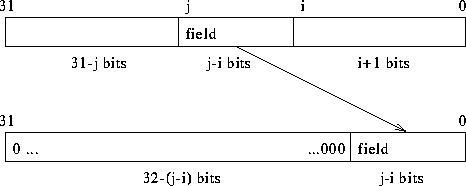Homework 3
CS 220
50 points, due Oct. 17, 1997
- (15 pts.)
Represent the decimal values 26, -37, 497, and -123 as signed, 10-bit
numbers in the following binary formats:
- sign and magnitude.
- 1's complement.
- 2's complement.
- (15 pts.)
Consider a ``downsized'' IEEE FP standard for 12-bit FP numbers. The
exponent is a 5-bit bias 15 number and the fractional mantissa is 6 bits.
- Represent the decimal numbers 1.7, -0.012, 19, and 0.125 in this
format.
- What are the smallest and largest numbers representable in this
format?
- How does the range calculated in part (b) compare to the ranges of
a 12-bit signed integer and a 12-bit signed fraction?
- (5 pts.)
Some computers have explicit instructions to extract an arbitrary field
from a 32-bit memory word and place it in the least significant bits of
another memory word, like this:

Find the shortest sequence of SAL instructions that extracts a field for
the constant values i=7 and j=19 from the word variable source
and places it in the word variable destination.
- (5 pts.)
Determine the minimal SAL instruction sequence which will swap two word
variables, say i and j, without using any other
variables.
- (10 pts.)
Joe Pro designed a new CPU chip, forgetting to implement any
arithmetic/logic instructions other than or, add, and
sub. He used 2's complement integer representation. Help Joe to find the
shortest sequence of instructions to perform the not and and
bit operations.
Thomas P. Kelliher
Tue Oct 7 18:47:40 EDT 1997
Tom Kelliher
